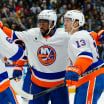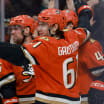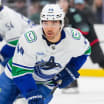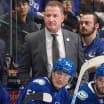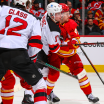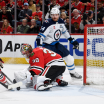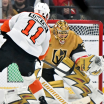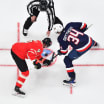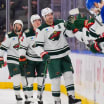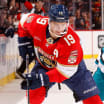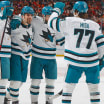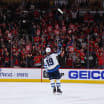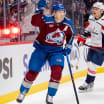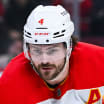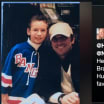REGINA, Saskatchewan -- David Gregory and Matt Ryan of NHL Central Scouting arrived in the lobby of their hotel with no time to spare.
Gregory, who had just driven 225 miles here in just under four hours from Brandon, Manitoba, approached the receptionist, provided identification, got his room key and asked, "When does the kitchen close?" She responded, "Fifteen minutes."
On road with NHL Central Scouting
Inside look at League's well-traveled talent evaluators in action
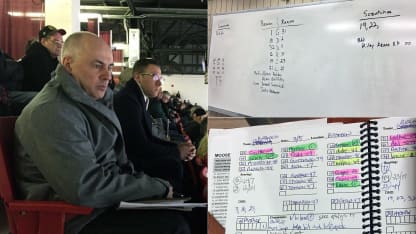
Gregory then turned to Ryan: "Back down in 10 minutes to get a bite?"
They met nine minutes later and were the only patrons that Sunday night. Sitting side by side on bar stools, they talked shop and discussed the travel agenda for the following day. They ordered their meals and some local refreshments, shared some laughs and war stories of scouting trips with the bartender before calling it a night.
It was 11:45 p.m.
The plan was to meet in the lobby five hours later for a flight from Regina to Seattle via Vancouver.
\[Related: Six WHL prospects to watch\]
Light snow was falling and it was minus-4 degrees (Fahrenheit) when Gregory sent Ryan a text message at 4:45 a.m., informing him their flight to Vancouver was canceled because of heavy winds. Less than 30 minutes later, an updated itinerary was arranged consisting of a two-hour flight from Regina to Vancouver, followed by a 142-mile, three-hour drive to Seattle. Gregory arranged the flight; Ryan arranged the car rental.
There were benefits to all of this: an extra three hours' sleep and chance to call home.
This is just a glimpse into the life of an NHL scout. It's not easy, and most of the time unforgiving.
"Wherever the players are, you have to go," Gregory said.
Gregory and Ryan go see those players for NHL Central Scouting, which was established prior to the 1975-76 season as a service for the League's teams. The Toronto-based department consists of director Dan Marr, eight full-time scouts and 16 part-time scouts throughout North America. The NHL also employs the services of Goran Stubb and his five-member staff at European Scouting Services in Finland to evaluate prospects overseas.
The combined scouts reporting for NHL Central Scouting will see about 3,000 games this season.
Gregory and Ryan scheduled their longest road trip of the season to evaluate many of the top players from the Western Hockey League during 13 days beginning Feb. 28 in Regina and concluding March 12 in Portland, Oregon.
\[Related: Mike G. Morreale's 2017 NHL mock draft\]
"I hate to say it's hard work because we love what we do and we're happy and privileged to be working in the industry," Gregory said. "But it's harder work than people realize. You have to put in the effort, have to grind, so you can have an opinion."
The two-week trip required 28 hours of driving and stretched about 1,466 miles. It allowed them to witness 12 teams and 13 blue-chip prospects from the top 62 on NHL Central Scouting's midterm list of North American skaters eligible for the 2017 NHL Draft.
"It's tough being on the road and not spending as much time that normal married couples would outside the industry," Ryan said. "Did my wife think it would be this much time away? Probably not. But it takes an excellent support system to be able to spend so much time away and we have that."
Marr allowed NHL.com to travel with Gregory and Ryan for five days (March 3-7) of their WHL road trip.
The journey included two viewings of Brandon center Nolan Patrick, No. 1 on that midterm list. The experience was eye-opening and educational.
The scouts
Anyone strolling into the hotel restaurant at the time Gregory and Ryan were there on March 5 probably would have thought the two were college buddies catching up on old times, but there is a 23-year age difference.
You'd never know it. The friendship, camaraderie and respect -- you can sense it by how they speak to and listen to each other.
Gregory, 56, has been a fixture at NHL Central Scouting the past 14 years. He's married and the father of three sons: Greyson, 26; Lyle, 24; and Kade, 22. Lyle works for the Chicago Blackhawks as an assistant in hockey operations.
David Gregory was raised around hockey. The son of Hockey Hall of Famer and former director of NHL Central Scouting Jim Gregory, he was hired at the same time E.J. McGuire joined the bureau. McGuire served as director for six seasons before dying of cancer on April 7, 2011.
"I did some pro scouting prior to taking the position at Central, but pro scouting is completely different than amateur scouting," Gregory said. "You go from watching players 20 to 27 years old to watching 16-to-18-year-olds and it's not easy. E.J. was good at projecting and he told me to trust what I was seeing.
"He recommended I compare players to their peers and to guys already drafted but still playing junior hockey. It's a formula that has worked for me."
Ryan, 33, played 12 games with the Los Angeles Kings in 2005-06. The right-handed center also starred for Guelph of the Ontario Hockey League and played four seasons for Manchester of the American Hockey League. He played seven seasons in Europe, including his final two in the Elite Ice Hockey League for Nottingham and Dundee before deciding to return home to Canada when his wife became pregnant with their second child. Ryan, who lives in Bradford, Ontario, has two boys: Kingsley, 3, and Livingston, 22 months.
He started coaching at a few clinics before becoming familiar with scouting and player evaluation through Guelph general manager Mike Kelly, who would later introduce Ryan to Marr. Ryan was hired by Central Scouting in 2015.
"When you get into this business I think everyone wants to believe you have the ability to find that player or identify a player that will help an NHL team attain their ultimate goal of winning the Stanley Cup," Ryan said.
On the road again
For any scout, creating an itinerary outside the normal region is always a challenging proposition.
Ryan spends a majority of the season evaluating players from the OHL, and Gregory spends time tracking players in the northeastern United States. They also take advantage of any opportunity to schedule crossover viewings to help colleagues by providing an additional look at specific players and teams in another region, as was the case in making the trip out West.
"Different guys have different preferences," Gregory said. "Some might want to stay in one place and do a little more driving and not have to change hotels. Some will drive, spot to spot, and change hotels."
During their five days on the road with NHL.com, the scouts reserved rooms at five hotels to watch three games. They prefer to stay at one location when on the road and drive to different venues from that centralized spot instead of reserving several plane tickets. On the first leg of their WHL trip, the central point was Regina.
"I don't mind traveling at all, but in bad weather it could be challenging," Gregory said. "Most of the driving occurs after games when the traffic is usually a little better. Back home (in Massachusetts) I have to do a lot of driving because there's nothing real close, so I'm used to that. You just get it done."
During the car ride from Vancouver to Seattle on March 6, visibility wasn't great for Ryan; there was a steady snowfall mixed with hail before they reached U.S. Customs and Border Protection. Ryan said that so long as he had some coffee and a reliable car, he was good to go. It also helped to have some company with him.
"Sometimes, if I'm on my own and have a break between games, that's a good time to make some calls and catch up with some people in the industry and see what's going on," Ryan said. "It gives me a chance to follow up on any leads. Sometimes I might have to call a general manager to find out if a player is in the lineup. I also might reach out to one of my fellow scouts to see or get some information on a player before watching him. You always have to make good use of the time you have on your own."
Here was the WHL itinerary for Gregory and Ryan:
Feb. 28: Fly to Regina (drive to hotel); Brandon at Swift Current (via car from Regina)
March 1: Calgary at Moose Jaw (via car from Regina)
March 2: Off day in Regina
March 3: Kootenay at Saskatoon (via car from Regina)
March 4: Calgary at Regina (drive to Brandon hotel after night game)
March 5: Regina at Brandon (drive to Regina hotel after day game)
March 6: Off day in Regina (fly to Vancouver, drive to Seattle)
March 7: Spokane at Seattle
March 8: Prince George at Portland (via car from Seattle)
March 9: Drive to Tri-Cities, Washington, hotel
March 10: Prince George at Tri-City
March 11: Everett at Tri-City
March 12: Everett at Portland (via car from Tri-Cities)
March 13: Fly home from Seattle
Pregame routine
When Gregory and Ryan reached the scouts room two hours before puck drop at Westman Place in Brandon on March 5, each took a seat at a long table, removed a notepad from his case and began jotting down lineups for the game. They were written on a white board that hung at one end of the room. Each scout was also given a media kit with rosters and game notes.
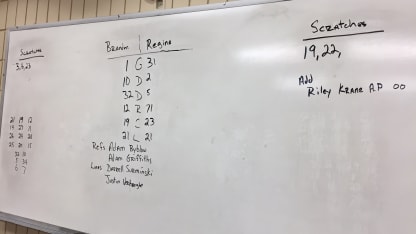
There were many top players to watch, including Patrick, the projected No. 1 choice in the 2017 draft, and Brandon right wing Stelio Mattheos, No. 23 on NHL Central Scouting's midterm ranking of North American skaters. Even Brandon center Reid Duke, who less than 24 hours after the game became the first player to sign with the expansion Vegas Golden Knights, was reviewed as an overage (20-year-old) possibility.
They were also looking forward to evaluating Regina right wing Nick Henry, No. 25 among North American skaters.
"A lot of my homework will be done before I get to the rink," Ryan said. "I'm just trying to get a feel on player numbers and become familiar with their stats and tendencies. When I arrive at the rink and start going through the lines, I look for possible matchups you might see and some of the challenges that these top guys might face."
Ryan said he likes to view a potentially draft-eligible player in his region for the upcoming draft between 20-40 times before NHL Central Scouting's final meeting of the season, at its Toronto headquarters in April, when the full-time scouts determine the final rankings of the top North American skaters and goalies. He won't be able to get that many evaluations during crossover viewings.
"We write down the line combinations because the game is fast, so you have to be able to quickly reference who you're looking at," Gregory said. "Personally, I chart who the overage or drafted players are in the game. I chart the draft-eligible players and anybody we have ranked on our list, and then the underage players. I use highlighters with different colors so I can quickly reference the line charts and know who is who."
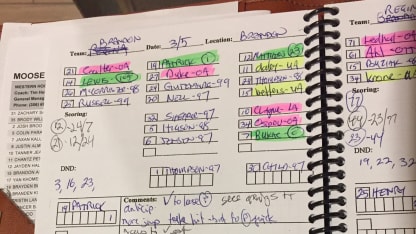
Unfortunately, the scouts didn't get to see Regina center Jake Leschyshyn, who is out for the season with a lower-body injury. Central Scouting ranks Leschyshyn No. 31 among North American skaters.
"Sometimes when we're chasing players around and players get injured, a game that looked important suddenly isn't as much anymore," Gregory said. "That might be a time you could have been somewhere else but you can't plan that stuff in advance. You stick with it and make the most of it."
The art of scouting
How does Gregory view scouting?
"When I first started, it was like when you go to a new grocery store and in order to make sure you get the stuff you need you go up and down the aisle six times," he said. "But after you've done it awhile you'll go up and down each aisle once and you're out of there. It's the same thing with scouting. You gradually learn how to travel, how to manage your time and how to watch the players."
There are a few areas of scouting in which enhanced statistics are a distant second to the old-school, eye-in-the-sky approach. The scouts are assessing hockey sense, skating and competitiveness, three areas Gregory and Ryan agree are vital to projecting success.
"A good understanding of those three areas of a player can help you determine if someone will translate well to the next level," Gregory said. "If they are a bona fide first-round pick, they have to be able to show a lot of strength in those areas and be elite in their draft class to be at the top of it."
Gregory and Ryan wait until the opening faceoff before determining where to sit for the game; they usually find a place along the back row of a section of seats near center ice. Gregory and Ryan take out their notebooks and occasionally will glance at the rosters and write down a few important words that summarize a player. When they need to write a full report on a player for NHL Central Scouting, they will refer to the keywords and phrases -- such as "quickness," "agility," "finds open space," "works hard," and "good compete" -- they used to describe that player to help recall what they saw in that prospect.
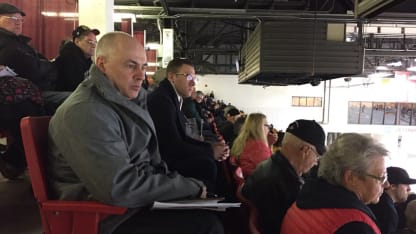
Listening to Ryan and Gregory share their insights regarding Patrick, it becomes apparent why they are so well-regarded within the industry.
"You have to be strong on pucks but you have to learn how to play without the puck," Ryan said. "You can get away with things in junior because defensemen don't gap up on plays. A lot of the defensemen at the junior level don't skate well enough and are afraid to get beat. So, guess what, they play off the skater and allow you that space. At the NHL level that doesn't happen. Straight-line hockey is becoming obsolete because everyone can skate so well. Everybody gaps up on plays, so how are you going to create space? You have to manipulate the gap by creating a speed differential. That's what the elite prospects like Nolan Patrick can do."
"If you have linemates who have anything close to the same level of an elite player, all of a sudden you start to get this chemistry and things begin to happen," Gregory said. "You need to take linemates into consideration when assessing talent. What makes Patrick so good is sometimes the puck is on his stick and it's gone before someone even blinks because he knows that's the right play to make. His ability to do that takes away any chance or time for the opponent to do something."
Gregory and Ryan each thought the fight between Patrick and Regina forward Austin Wagner (Los Angeles Kings) late in the second period was a spirited confrontation. It was the second fight of the season for Patrick.
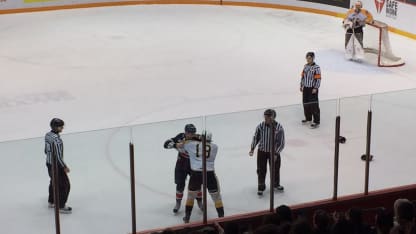
"I think he felt the team might not have had the intensity level that maybe he felt they should be playing with," Ryan said of Patrick. "The fact he's going to stand up for himself and let his teammates know that he's going to take the bull by the horns to help raise their compete level if they want success was interesting.
"As a coach, you don't want him doing that too often but you definitely don't want him to shy away from physically engaging himself."
Analyze this
One of the more interesting discussions during a four-hour drive from Brandon to Regina on March 5 was about analytics.
Gregory was driving and Ryan sat in the back seat. After stopping to refuel with three more rounds of coffee at a Tim Hortons, Ryan and Gregory dissected for NHL.com the world of enhanced statistics.
"Obviously anything you can do to gain more information that will allow you to make better decisions is good," Ryan said. "I think there will always be a need to see players live because it's a different element you get. I think watching a player and seeing the history of their body of work along with the underlying stats and psychology part of it, as far as player interviews and getting their background and motivation, are things that enable people to make the best decisions possible.
"What differs with analytics is how teams weigh them and bring them into their own decision-making equation. But I don't think analytics is going anywhere and, if anything, it's possibly going to be more influential moving forward."
Ryan believes Corsi or puck possession is the most influential number to consider when looking for an edge among players.
"Shot-based metrics have proven to be the best indicator of a player's ability to drive possession," Ryan said.
Gregory admits analytics have become an important part of the game and cannot be ignored.
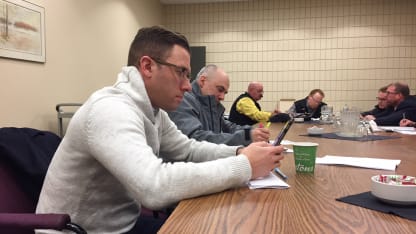
"It's just getting the right mix," Gregory said. "Everybody has a different take on how important or how much of the decision analytics should dictate. But I think your head is in the sand if you don't look to that to help you make decisions. Anytime you have information that helps you make a decision, you're making a better decision. Analytics has been around for a long time but, like anything else, the technology has gotten better and the results are proven in some areas.
"You need to find out how much icing you want on your cake as opposed to just plain cake. But don't put too much icing because it won't taste that great."
Family support
Throughout the trip, Gregory and Ryan always made it a point to praise their families for the support and encouragement they provide.
"[Dolores] has been unbelievable," Gregory said of his wife. "Even before hockey we moved to an area where we didn't have a lot of family so she was, in a sense alone, taking care of the kids and taking them where they needed to be at all times of the day. Yes, you're grinding it out and working very hard but your wife is working harder at home."
Gregory believes every scout in the business has likely missed some special family occasion or holiday because there is no breaks when it comes to scouting.
"In our industry, games are on the holidays so most of the time you don't get those days," he said.
Ryan knows how difficult it is for his wife, Natalie, with two young boys at home.
"She does all the heavy lifting throughout the season," Ryan said. "She understands this is my passion and I want to be in the game for a number of years so I'm very fortunate she's understanding and forgiving."
Projecting a future star
There are those who feel the 2017 draft isn't as strong as previous ones. The past two drafts have been heavy on highly touted prospects: Connor McDavid and Jack Eichel in 2015, and Auston Matthews and Patrik Laine in 2016.
"This year might not be as clear-cut, but I do believe there's excellent value," Ryan said. "I believe there might be some guys that need a little extra time. In previous years there were more guys probably NHL-ready to step into the lineup. This year players may need some time. But that doesn't mean they're going to be any less productive when they finally reach the NHL."
Gregory said he doesn't feel any more or less pressure because there may be some uncertainty at the top of this year's draft class. It's more about just making sure he has a good grasp on the players he watches throughout the season.
"I think the one thing I've learned over time is you can only say what you know," Gregory said. "People ask us about players and you tell them. You can't be tempted to try and project what you haven't seen yet or if you haven't had the opportunity to see them enough.
"Multiple viewings give you the picture of a player. I've learned to say that 'I've only seen this guy once, but this is what I saw.' I just tell people what I'm most confident in what I believe about a player."
A sizeable number of NHL scouts attended the Spokane-Seattle game on March 7 because Seattle is considered by many to be a legitimate contender to win the WHL championship this season and Spokane has right wing prospect Kailer Yamamoto, No. 17 on NHL Central Scouting's midterm list.
The opportunity to sit beside Ryan and watch the game as a scout in Seattle was special. A reporter bounced observations off of him and he either confirmed those assessments or respectfully provided a reason why he thought otherwise.
When a reporter mentioned that Yamamoto (5-foot-7, 153 pounds) seemed a lot tougher than expected, Ryan said: "That's not something you think about in his game when you mention his size and stature but he took a big [hit] in the first and it didn't stop him from playing in the high-traffic areas or engaging in battles at any point in the game. He has a high compete level, and that's what NHL teams want to see."
It is also an element to Yamamoto's game that cannot be obtained through statistics, illustrating why NHL scouts are still so very vital and in high demand.
"It's funny," Gregory said. "Even after doing this for such a long time I still wonder entering a game if I'm going to be able to figure these players out. It you give it time and look for the things that you've traditionally done over the years, you eventually do figure players out.
"It's all about projecting for us, and projecting early. We have to be prepared to say things and that's what makes it fun because people want to know what you're seeing and thinking, and if your history is good and you have a good opinion, it makes for a really fun job."
